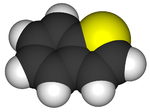Thianaphthene
 |
|
 |
|
| Names | |
|---|---|
|
IUPAC name
Benzo[b]thiophene
|
|
| Other names
Benzo[b]thiophene. 1-benzothiophene
Thianaphthene Benzothiofuran |
|
| Identifiers | |
|
3D model (JSmol)
|
|
| ChEBI | |
| ChemSpider | |
| ECHA InfoCard | 100.002.178 |
| EC Number | 202-395-7 |
|
PubChem CID
|
|
| RTECS number | 202-395-7 |
| UNII | |
|
|
|
|
| Properties | |
| C8H6S | |
| Molar mass | 134.20 g·mol−1 |
| Appearance | White solid |
| Density | 1.15 g/cm3 |
| Melting point | 32 °C (90 °F; 305 K) |
| Boiling point | 221 °C (430 °F; 494 K) |
| Hazards | |
| GHS pictograms |
 
|
| GHS signal word | Warning |
| H302, H411 | |
| P264, P270, P273, P301+312, P330, P391, P501 | |
| Flash point | 110 °C (230 °F; 383 K) |
| Related compounds | |
|
Related compounds
|
Thiophene Indole Benzofuran |
|
Except where otherwise noted, data are given for materials in their standard state (at 25 °C [77 °F], 100 kPa).
|
|
|
|
|
| Infobox references | |
Benzothiophene is an aromatic organic compound with a molecular formula C8H6S and an odor similar to naphthalene (mothballs). It occurs naturally as a constituent of petroleum-related deposits such as lignite tar. Benzothiophene has no household use. In addition to benzo[b]thiophene, second, uncommon isomer is known, benzo[c]thiophene.
Benzothiophene finds use in research as a starting material for the synthesis of larger, usually bioactive structures. It is found within the chemical structures of pharmaceutical drugs such as raloxifene, zileuton, and sertaconazole, and also BTCP. It is also used in the manufacturing of dyes such as thioindigo.
...
Wikipedia
